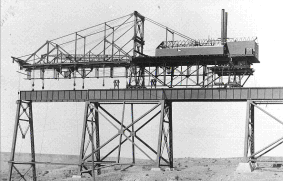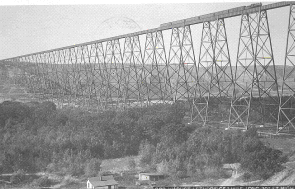
Before the High Level Bridge was built in Lethbridge the trip to fort Macleod was very hard to travel. The original line between Lethbridge and Fort Macleod was constructed in 1897-1898 as part of a line between Medicine Hat and Kootenay Landing in British Columbia. This section of line was dangerous because of the landscape of the area. The C.P.R. had to build wooden bridges in order to cross the numerous coulees and Old Man River tributaries. After a time these bridges were unable to handle the weight of continuous locomotive traffic. By 1904 the 20 wooden bridges were in poor shape. They became very expensive to repair and were still very slow to cross. Because of the old wooden bridges and the new train station in Lethbridge the C.P.R. began to plan a new line that could better handle the increasing traffic.

P19720145000-GP The building of the High Level Bridge replaced many old, wooden structures such as this one.
In June, 1906, it was announced that the C.P.R. would build a bridge across the Belly River Valley (later known as the Oldman River). Because it was so big newspapers across the country called it one of the wonders of the world. When construction began in November the C.P.R. had decided on a steel bridge to cross the 1.6 kilometre wide valley. The construction of the viaduct was done in various stages. The first stage in building the bridge was measuring the river valley. This work set out the exact length of the structure, 1839 meters. The measuring also showed the location of the massive piles that would support the bridge.

P19921028004-GP The erection traveller used in the construction of the High Level Bridge.
Construction of the High Level Bridge began in September, 1907. The contract for building the bridge was awarded to the Canadian Bridge Company. Important to the construction of the structure was the use of a machine called the Erection Traveler. The traveler was built on site specifically for the construction of the High Level Bridge. The traveler was designed to allow Standard locomotives to pass underneath it to supply steel to the traveler. The traveller weighed 323 636 kilograms and stood 20 metres high. It took one month to build, and cost $100 000. Because of this and the hard work of hundreds of men, the bridge took two years to build. Construction on the High Level Bridge was completed on June 23, 1909.
The Lethbridge High Level Bridge is still the highest and longest steel railway bridge in the world. It is 1839 meters long and rises 105 meters above the river bed. The bridge contains 12 500 tonnes of structural steel and it took 31 920 litres of paint to give it the original two black coats. In the end, it cost over $1 500 000 to complete.

P19640699000-GP The completed High Level Bridge. The train crossing the structure might put its size into perspective for you.
This bridge is important because it is a symbol of Canadian success. At the time the bridge was built the Canadian economy was growing faster than that of the United States, and the High Level Bridge was an example of the growing economic confidence that Canadians were feeling. The bridge today is a unique symbol of Lethbridge and a reminder of the city’s past.
 The Mystery of the Fallen Rail
The Mystery of the Fallen Rail Previous Page | Exhibit Contents | Home | Navigation Information | Glossary | Curriculum Guide | Next Page
Copyright © 1996 Sir Alexander Galt Museum. All rights reserved.